
An apartment, flat, or unit is a self-contained housing unit that occupies part of a building, generally on a single storey. There are many names for these overall buildings. The housing tenure of apartments also varies considerably, from large-scale public housing, to owner occupancy within what is legally a condominium, to tenants renting from a private landlord.
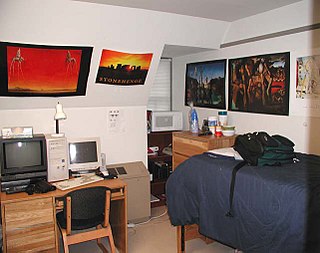
A dormitory is a building primarily providing sleeping and residential quarters for large numbers of people such as boarding school, high school, college or university students. In some countries, it can also refer to a room containing several beds accommodating people.
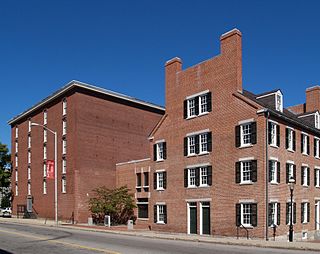
A boarding house is a house in which lodgers rent one or more rooms on a nightly basis, and sometimes for extended periods of weeks, months, and years. The common parts of the house are maintained, and some services, such as laundry and cleaning, may be supplied. They normally provide "room and board," that is, some meals as well as accommodation.

A studio apartment, or studio condo also known as a studio flat (UK), self-contained apartment (Nigeria), efficiency apartment, bed-sitter (Kenya), or bachelor apartment, is a small dwelling in which the normal functions of a number of rooms – often the living room, bedroom, and kitchen – are combined into a single room.

Communal apartment are condominium-like apartments with 4, 8 or more living rooms that share common area like stove, shower, toilet etc. They generally lack privacy. Up until dissolution of the Soviet Union all communal apartments were treated as public housing. With the start of privatization in Russia such apartments started to gain ownership.

Single room occupancy is a form of housing that is typically aimed at residents with low or minimal incomes who rent small, furnished single rooms with a bed, chair, and sometimes a small desk. SRO units are rented out as permanent residence and/or primary residence to individuals, within a multi-tenant building where tenants share a kitchen, toilets or bathrooms. SRO units range from 7 to 13 square metres. In some instances, contemporary units may have a small refrigerator, microwave, or sink.

Housing in Japan includes modern and traditional styles. Two patterns of residences are predominant in contemporary Japan: the single-family detached house and the multiple-unit building, either owned by an individual or corporation and rented as apartments to tenants, or owned by occupants. Additional kinds of housing, especially for unmarried people, include boarding houses, dormitories, and barracks.

Housing at the University of California, Berkeley, includes student housing facilities run by the office of Residential and Student Service Programs (RSSP). Housing is also offered by off-campus entities such as fraternities and sororities and the Berkeley Student Cooperative (BSC).

A house in multiple occupation (HMO), or a house of multiple occupancy, is a British English term which refers to residential properties where 'common areas' exist and are shared by more than one household.
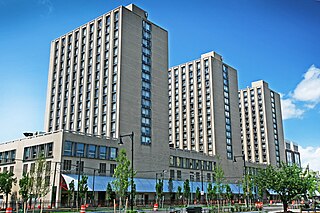
The Boston University housing system is the 2nd-largest of any private university in the United States, with 76% of the undergraduate population living on campus. On-campus housing at BU is an unusually diverse melange, ranging from individual 19th-century brownstone town houses and apartment buildings acquired by the school to large-scale high-rises built in the 60s and 2000s.

A rooming house, also called a "multi-tenant house", is a "dwelling with multiple rooms rented out individually", in which the tenants share kitchen and often bathroom facilities. Rooming houses are often used as housing for low-income people, as rooming houses are the least expensive housing for single adults. Rooming houses are usually owned and operated by private landlords. Rooming houses are better described as a "living arrangement" rather than a specially "built form" of housing; rooming houses involve people who are not related living together, often in an existing house, and sharing a kitchen, bathroom, and a living room or dining room. Rooming houses in this way are similar to group homes and other roommate situations. While there are purpose-built rooming houses, these are rare.

An apartment hotel or aparthotel is a serviced apartment complex that uses a hotel-style booking system. It is similar to renting an apartment, but with no fixed contracts and occupants can "check out" whenever they wish, subject to the applicable minimum length of stay imposed by the company.
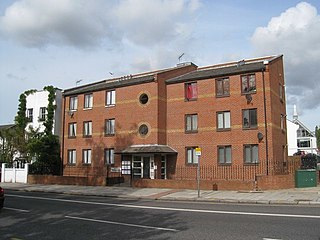
Multifamily residential is a classification of housing where multiple separate housing units for residential inhabitants are contained within one building or several buildings within one complex. Units can be next to each other, or stacked on top of each other. A common form is an apartment building. Many intentional communities incorporate multifamily residences, such as in cohousing projects. Sometimes units in a multifamily residential building are condominiums, where typically the units are owned individually rather than leased from a single apartment building owner.
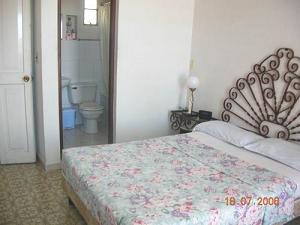
Casa particular is a phrase meaning private accommodation or private homestays in Cuba, very similar to a bed and breakfast, although it can also take the form of a vacation rental. When the meaning is clear, the term is often shortened to simply casa. Today, many casas particulares are rented through online agencies, some specifically Cuban, and others that work worldwide.

A housing unit, or dwelling unit, is a structure or the part of a structure or the space that is used as a home, residence, or sleeping place by one person or more people who maintain a common household.

In a building or large vehicle, like a ship, a room is any enclosed space within a number of walls to which entry is possible only via a door or other dividing structure that connects it to either a passageway, another room, or the outdoors, that is large enough for several people to move about, and whose size, fixtures, furnishings, and sometimes placement within the building or ship support the activity to be conducted in it.

A kitchenette is a small cooking area, which usually has a refrigerator and a microwave, but may have other appliances - for example a sink. They are found in furnished basements, small apartments, some motel and hotel rooms, college dormitories, office buildings, or bedrooms in shared houses. New York City building code defines a kitchenette as a kitchen of less than 7.4 m2 (80 ft2) of floor space.
A chambre de bonne is a type of French apartment consisting of a single room in a middle-class house or apartment building. It is generally found on the top floor and only accessible by a staircase, sometimes a separate "service staircase". Initially, these rooms were intended as the bedroom for one of the family's domestics, and the name originates from the colloquial name for such maids: a "bonne à tout faire". Today, chambres de bonne are usually the cheapest rung on the Parisian letting market, and are primarily rented by less well-off workers and students. They are also in high demand among workers who wish to maintain a small room or postal address in a big city, especially Paris.
Face-me-I-face-you or Face-to-face is a term for a specific type of residential real estate in Nigeria, where a group of one or two-room apartments have their entrances facing each other along a walkway, which leads to the main entrance of the apartment building. "Face-me-I-face-you" apartment buildings are very common architectural style in major urban settlements in Nigeria; the flats are low rent and are commonly rented to the low income residents because of their affordability.

A microapartment, also known as a microflat, is a one-room, self-contained living space, usually purpose built, designed to accommodate a sitting space, sleeping space, bathroom and kitchenette with 14–32 square metres. Unlike a traditional studio flat, residents may also have access to a communal kitchen, communal bathroom/shower, patio and roof garden. The microapartments are often designed for futons, or with pull-down beds, folding desks and tables, and extra-small or hidden appliances. They differ from bedsits, the traditional British bed-sitting room, in that they are self-contained, with their own bathroom, toilet, and kitchenette.


















